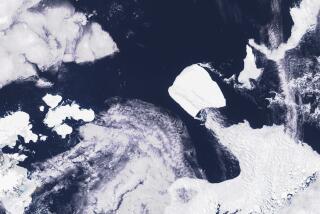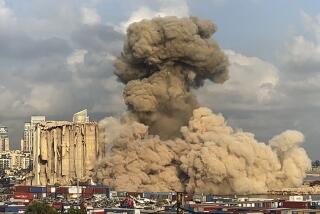Chunk of Antarctic ice shelf collapses
- Share via
WASHINGTON — A chunk of Antarctic ice about seven times the size of Manhattan has collapsed, scientists said Tuesday, putting an even greater portion of glacial ice at risk.
Satellite images show the runaway disintegration of a 160-square-mile chunk in western Antarctica that started Feb. 28. It was the edge of the Wilkins Ice Shelf and had been there for perhaps 1,500 years.
British Antarctic Survey scientist David Vaughan attributed the melting to rising sea temperature due to global warming.
Scientists said that while they were not concerned about a rise in sea level from the latest event, it was a sign of worsening global warming.
Such occurrences are “more indicative of a tipping point or trigger in the climate system,” said Sarah B. Das, a scientist at the Woods Hole Oceanographic Institution in Massachusetts.
“These are things that are not re-forming,” Das said. “So once they’re gone, they’re gone.”
Because scientists noticed satellite images of the event within hours of its start, they diverted satellite cameras and flew an airplane over the ongoing collapse to capture rare photos and video.
“It’s an event we don’t get to see very often,” said Ted Scambos, lead scientist at the National Snow and Ice Data Center in Boulder, Colo. “The cracks fill with water and slice off and topple. . . . That gets to be a runaway situation.”
The rest of the Wilkins Ice Shelf, which is about the size of Connecticut, is holding on by a narrow beam of thin ice. Scientists worry that it too may collapse.
Larger, more dramatic ice collapses occurred in 1995 and 2002.
Vaughan had predicted that the Wilkins shelf would collapse about 15 years from now. The part that recently gave way made up about 4% of the overall shelf, but it was an important part that can trigger further collapse.
There’s still a chance the rest of the ice shelf will survive until next year because this is the end of the Antarctic summer and colder weather is setting in, Vaughan said.
The climate in Antarctica is complicated and unique because of the continent’s isolation.
Much of Antarctica is not warming, and some parts are even cooling, Vaughan said. However, the western peninsula, which includes the Wilkins Ice Shelf, juts out into the ocean and is warming.
Scientists are most concerned about melting ice in this part of the continent triggering a rise in sea level.






